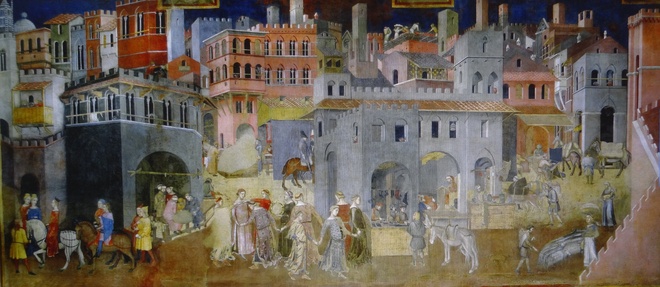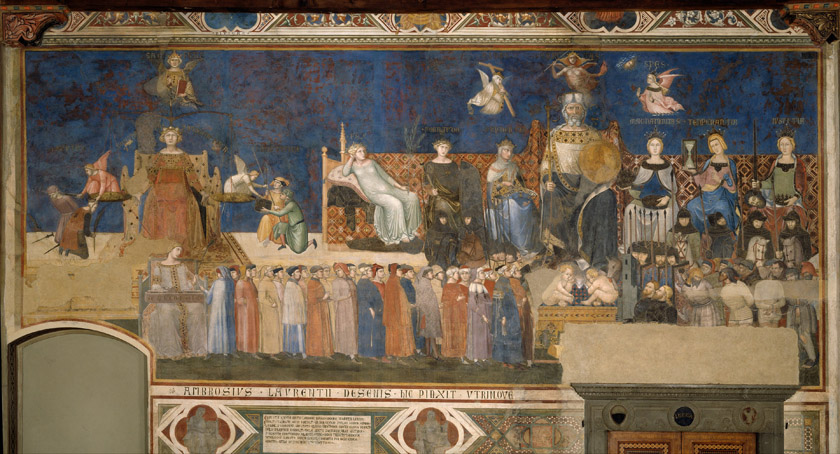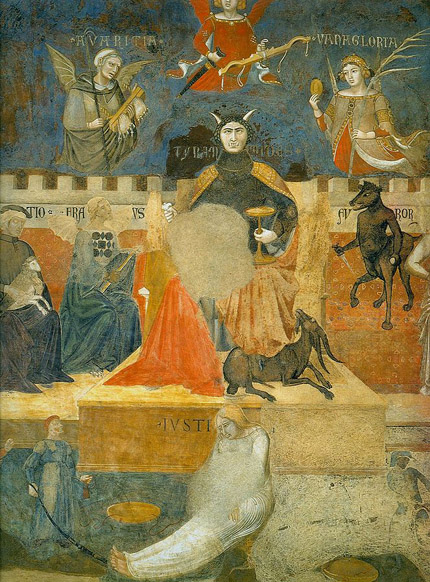
Realism in symbolism: Allegory of Good Government (showing Peace reigning in the city)
BN Goswamy
A wise and frugal government, which shall restrain men from injuring one another, shall have them otherwise free to regulate their own pursuits of industry and improvement, and shall not take from the mouth of labour the bread it has earned. This is the sum of good government. — Thomas Jefferson
…art is the overcoming of the past. All is presence in art. It becomes presence.’ — Hans-Georg Gadamer
The year was 1338, or thereabouts, and the place was Siena, that scenic drenched-in-history town in central Italy, just south of Florence. It was then the centre of a Republic and its governance was in the hands of a Council of Nine — wise men chosen by the citizenry — who invited a gifted painter, Ambrogio Lorenzetti, to paint on the walls of the chamber, part of the Palazzo Pubblico, in which they used to meet, a number of frescoes. Lorenzetti, used to painting religious pictures, painted those of course — Madonna and Child, Ascension, Martyrdom et al. among them — but he also painted on those walls three remarkably complex, panoramic, panels: Allegory of Good Government, Effects of Good Government, and Allegory of Bad Government and its Effects on Town and Country. These superbly painted panels are still there, having survived close to seven centuries of time, serving as chaste reminders of what they were meant to convey to the wise Councillors of Siena, but, in many ways, also to us, living as we do in distraught times. The paintings naturally breathe the air of the past, now long gone, but the ringing message they hold is — how does one put it? — Timeless.

While working on his magnificent 7.7 meter long panel — the Allegory of Good Government — Lorenzetti leaned naturally upon early Greek ideas: that of Justice on the one hand and, on the other, the subordination of private interests to those of the common good. But he was referring to his own times. Consequently he brought in a personification of the leadership of his community in the form of an old person, with Christ-like features, wearing the colours of the Sienese coat of arms, seated on a throne, surrounded by the Cardinal Virtues: crowned, stately female figures representing Peace, Fortitude and Prudence on the left, and Magnanimity, Temperance and Justice on the right. Above everything is the heavenly sphere, with Faith, Hope, and Charity looking down upon everything, and, below, standing in homage are 24 noble citizens of Siena. Towards the left of this stately group is the beautifully drawn figure of Justice — lovely maiden on a high throne-like seat — looking up at the figure of Wisdom, book in hand, holding the scales of Justice. On the pan of the scale at right, as we see it, is an angel distributing rewards and, at left, another angel meting out punishment for evil deeds. From these scales descend two cords which wind down, reach the hands of another maiden who names them Concord — harmony in other words — and sends them trailing, binding together the crowded group of citizenry. Meanwhile, while everything is in place, the gentle figure of Peace reclines back on her seat, holding a palm-frond in one hand. A plethora of other symbols are strewn all over the panel, each needing careful decoding by us but evidently clear in their import to the Council of Nine that ran the Republic.

On another wall, at right angle to this panel, are scenes of the city of Siena representing the Effects of Good Government. A sense of quiet and order reigns here. From the height of their homes, men and women calmly peer down; the streets are bustling with people but there are no signs of discord. A sense of plenty prevails. Commerce flourishes; shopkeepers sell their wares; people pause in the street to talk to one another; in a joyous group at left, nine women break into a slow dance, representing, possibly, the nine Muses. Just outside the limits of the city are open, gently undulating spaces reminding one of the landscape of Siena of today. There gentlemen on horseback set out for hunting; farmers take their pigs to the market; donkeys are loaded with grain; there is sowing and harvesting. It is an idyll that Lorenzetti paints here: all, as he presents it, is the result of good government.

Quite the opposite happens on the facing wall where the effects of bad governance swing into view. Here, the scene is dominated by the presiding figure, marked by horns and fangs, who is identified as Tyranny. He sits enthroned, resting his feet upon a goat — symbol of luxury and lust — and holding a dagger in his hand. On his left is Cruelty, seen as tormenting a baby with a snake; next come Treason shown as a man holding a lamb with a scorpion’s tail, and Fraud: a woman with bats wings and claws as feet. At right are the figures of War and Division and Fury, and above everything hover Greed, Pride, and Vainglory. Justice, hands and feet tied, is lying at the feet of Tyranny, her scales broken and lying by her side. The city seems filled with despair: shops and schools are empty; people are being knocked down in the street, and arrested without recourse to justice. Outside the city, the countryside looks barren: burnt and ransacked. Nothing grows, and fear seems to reign supreme.
There are things here to ponder over. All this, seen through the heroic eyes of the painter, and possibly of the Council of Nine, was then: seven hundred years ago. The question that can linger in the air above us, however, and nag us, is that is all this to be discarded because it is old? Antiquated? Or, thinking differently, are all those traits and virtues that serve as reminders in these panels — Wisdom, Peace, Fortitude, Prudence, Magnanimity, Temperance, Justice — still of relevance because they make for good governance? And, again, all that one sees in these panels making for bad governance — Tyranny, Cruelty, Treason, Fraud,, Division, Fury, Greed, Pride, Vainglory — are things that one should be constantly wary of? Using the tongue of old, I would say: ‘Methinks they are’.
Join Whatsapp Channel of The Tribune for latest updates.


























